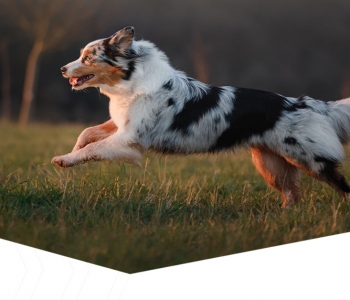
Feeding the ‘Sports Star’ for endurance and performance
Modification of nutrition is one of the easiest and most effective ways to improve performance in a sporting dog.
There are many misconceptions about the characteristics of the best diet for performance dogs but if nutritional needs are balanced properly, nutrition will provide a strong foundation and even make or break an effort for success.
Here we discuss diet for the performance dog, paying particular attention to the three energy nutrients of fat, protein and carbohydrates.
“Which ingredients should be incorporated into my dog’s diet?”
It will come as no surprise to you that specially formulated commercial diets for athletic, sporting and performance dogs should be energy dense and highly palatable.
A balanced diet for sporting dogs should also include optimum protein and fat levels, allow for repletion (replacement) of muscle glycogen (the storage form of glucose), provide ample energy to support muscle contraction during athletic bouts, and be palatable and readily accepted during training, especially while under the stress of competition.
That’s a lot of work so it’s super important to get itas close to perfect as you can..
Energy requirements are provided by fat, protein, and carbohydrates. Let’s take a closer look:
Carbohydrates
Nutritionists know the main source of energy for the performance dog should come from fat or carbohydrate. The debate has been which of these two components is most important in increasing performance and endurance.
Most of us are familiar with the popular “carbohydrate loading” done by long distance runners prior to a race. A large plate of pasta and bread the day before an endurance run increases the stored carbohydrate (glycogen) in the runner’s muscles and allows for better performance.
Some dog trainers have merely transposed the success of carbohydrate loading in humans to the canine athlete, but the effect in dogs has not been the same.
In the early seventies, it was observed that sled dogs fed high-carbohydrate rations actually had poor endurance and even a stiff gait while racing.¹ It was theorised that excess glycogen led to increased lactic acid build-up in muscle tissue and decreased the dogs’ performance. The dogs were switched to a high-protein, high-fat diet and performance increased and the stiff gait disappeared.
Fat
Fat has a direct role in athletic performance because it provides the most concentrated form of energy of all the nutrients. An average fit dog has about 50 times more energy deposited in fat stores than in its stores of muscle glycogen.
Dietary fat is also a source of essential fatty acids, and allows the absorption of essential fat-soluble vitamins. Containing 8.5 kcal of metabolisable energy (ME)/gram it is two times denser than protein or carbohydrates which both supply 3.5 kcal ME/gram. This means as the fat content in a diet increases, so too does its energy density.
High fat diets can begin to help dogs prepare for the training season weeks before increased activity actually begins. The level of Fatty Acids (FA’s) must be high for the performance dog to have extra energy (the principle product of fat metabolism used for energy is fatty acids). So, long before hard work begins, dogs fed high-fat diets will have high levels of FA’s in their blood stream which is extremely important in performance dogs.
What does this mean? To think of it more logically, it’s just like exercise. Trainers don’t wait to exercise their dog(s) until just one week before an event or show, similarly the same approach applies when feeding a high-fat diet. Don’t leave it too late.
Feeding a high-fat diet early allows maximum FA’s in the blood stream weeks before beginning stressful activity. This primes the dog giving him a head start. Of course, monitoring to prevent weight gain is important.
From a practical standpoint, many enthusiasts want to know just why dogs on high-fat rations perform better. Simply put, dogs fed this type of ration prior to training and competitions, are better able to utilize oxygen. In fact, studies show that a high-fat diet can increase performance and endurance as much as selective breeding.¹
While competitors might be tempted to just add additional fat to the diet, there are several disadvantages to this including additional expense and the risk that too much of certain FA’s can cause bleeding disorders.³ A more suitable approach would be to feed a diet with a proven, safe and effective level of fatty acids.
Protein
There is evidence that protein requirements increase with exercise.
Very-low protein levels increase the chance of injury to performance dogs plus increasing the level of protein can decrease the incidence of injury.¹
For protein to be used efficiently by the body, it’s important that other nutrients are at optimal levels too. This helps ensure protein is not used for energy but reserved for tissue building and replacement.
Protein is actually one of the least desirable muscle fuels1 as the body cannot store it. Proteins are vital for making up the components that carry out important functions in the dog’s body; if protein in the diet is used for energy instead of making up essential cells and tissues, these functions can be impaired.
An observation with sled dogs compared the metabolic responses to training when fed diets deriving 16, 24, 32, or 40% of their total calories from high-quality animal protein. It showed the highest protein level maintained a larger plasma volume and red blood cell mass during strenuous training.1
All of the dogs consuming the low-protein diet had at least one injury during the racing season that resulted in it being removed from training for a minimum of one week.
Only 2 out of 8 dogs fed the 24% protein diet had serious injuries while none of the dogs fed the higher protein level diets had injuries.1
This work suggests that a highly athletic, adult endurance dog may have a minimum requirement of 24% of their calories coming from protein.
The protein found in Eukanuba Performance/Working and Endurance food provides 30% of the total calories, above the aforementioned 24%: it should be noted that most working dogs will not be as extreme as sled dogs in their protein energy requirements.
While simply adding fresh meat to a complete diet may seem like a good idea, this has some disadvantages. It can spoil, making storage a problem and food poisoning a possibility. It also contains a lot of water, making it less dense.
The good news is that high-quality complete dog foods like Eukanuba already contain readily available animal protein so there is no need to add additional amounts.
Conclusion
If nutrition is used properly, it provides a foundation for effective training and performance; if nutrition is not properly addressed it can handicap the benefits derived from training and ultimately affect performance.
The best approach is to provide an extremely high-quality commercial diet whichallows dogs to perform to theirgenetic and trained potential.
It’s simple. Find the best breeding available. Provide the best training and then, get your dog in top condition to compete by feeding a high-quality food with the correct levels of fat, carbohydrate and protein such as Eukanuba Performance/Working & Endurance.
References:
- Reynolds AJ, Taylor CR, et alThe effect of diet on sled dog performance, oxidative capacity, skeletal muscle microstructure, and muscle glycogen metabolism.In: Carey DP, Norton SA, Bosler SM, eds. Recent Advances in Canine and Feline Nutritional Research: Proceedings of the 1996 Iams International Nutrition Symposium. Wilmington OH: Orange Frazer Press, 1996; 181-198
- Reynolds AJ, FuhrerL, et al (1995).Effect of diet and training on muscle glycogen storage and utilisation in sled dogs. J Appl Physiol 79, 1601-1607
- Reinhart, Gregory: Fat for the Performance Dog; Performance Dog Nutrition Symposium; Colorado State University, April 1995.









